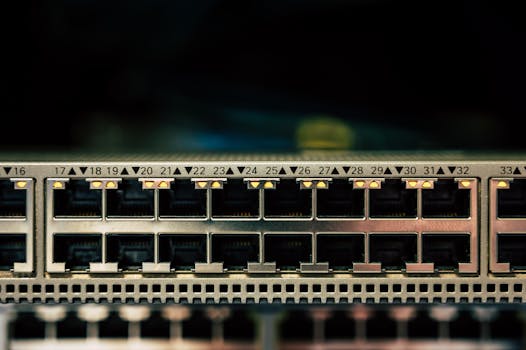From Copper to Fiber: The Revolution of Internet Infrastructure in Africa
The internet infrastructure in Africa is undergoing a significant revolution, shifting from traditional copper-based networks to modern fiber optic connectivity. This transformation is driving economic growth, improving communication, and enhancing the overall quality of life for millions of people across the continent.

From Copper to Fiber: The Revolution of Internet Infrastructure in Africa
The internet infrastructure in Africa is undergoing a significant revolution, shifting from traditional copper-based networks to modern fiber optic connectivity. This transformation is driving economic growth, improving communication, and enhancing the overall quality of life for millions of people across the continent. The transition from copper to fiber is not only a technological upgrade but also a strategic move to bridge the digital divide and promote socio-economic development in Africa.
Historically, Africa’s internet infrastructure was largely based on copper cables, which were prone to outages, theft, and degradation. The limited bandwidth and high latency of copper networks hindered the adoption of digital technologies, making it challenging for businesses, governments, and individuals to access online services and participate in the global digital economy. However, with the advent of fiber optic technology, Africa is now witnessing a rapid expansion of high-speed internet connectivity, which is transforming the way people live, work, and communicate.
The fiber optic revolution in Africa is being driven by significant investments in undersea cables, terrestrial fiber networks, and data centers. Several international and local companies are working together to deploy fiber optic cables across the continent, connecting major cities, towns, and rural areas. For instance, the Africa Coast to Europe (ACE) submarine cable, which spans over 17,000 kilometers, provides high-speed internet connectivity to 23 countries in West Africa. Similarly, the Seacom cable, which connects Africa to Europe and Asia, has enabled fast and reliable internet access for millions of people in Eastern and Southern Africa.
The impact of fiber optic connectivity on Africa’s economy and society is multifaceted. With faster and more reliable internet access, businesses can now operate more efficiently, accessing global markets, and communicating with customers and suppliers in real-time. The growth of e-commerce, online banking, and digital payments is also driving financial inclusion, enabling people to access financial services and conduct transactions securely and conveniently. Furthermore, fiber optic connectivity is facilitating the adoption of digital technologies in healthcare, education, and governance, improving the delivery of public services and enhancing the overall quality of life for citizens.
Section 1: The State of Internet Infrastructure in Africa
Africa’s internet infrastructure has historically been characterized by limited connectivity, high costs, and poor quality of service. The continent’s telecommunications sector has been dominated by traditional copper-based networks, which have struggled to meet the growing demand for high-speed internet access. However, with the advent of fiber optic technology, Africa is now witnessing a significant transformation in its internet infrastructure. The deployment of undersea cables, terrestrial fiber networks, and data centers is driving the growth of high-speed internet connectivity, which is expected to reach 50% of the population by 2025.
Section 2: The Benefits of Fiber Optic Connectivity
The benefits of fiber optic connectivity in Africa are numerous and far-reaching. With faster and more reliable internet access, businesses can now operate more efficiently, accessing global markets, and communicating with customers and suppliers in real-time. The growth of e-commerce, online banking, and digital payments is also driving financial inclusion, enabling people to access financial services and conduct transactions securely and conveniently. Furthermore, fiber optic connectivity is facilitating the adoption of digital technologies in healthcare, education, and governance, improving the delivery of public services and enhancing the overall quality of life for citizens.
Section 3: Challenges and Opportunities
Despite the significant progress made in deploying fiber optic connectivity in Africa, several challenges remain. The high cost of deploying fiber optic cables, particularly in rural areas, is a major obstacle to universal access. Additionally, the lack of digital literacy and skills is hindering the adoption of digital technologies, particularly among marginalized communities. However, these challenges also present opportunities for innovation and investment. The growth of fiber optic connectivity is creating new opportunities for businesses, governments, and individuals to develop digital solutions, products, and services that can drive economic growth, improve livelihoods, and enhance the overall quality of life for citizens.
Section 4: The Future of Internet Infrastructure in Africa
The future of internet infrastructure in Africa is exciting and promising. With the continued deployment of fiber optic cables, the growth of data centers, and the adoption of emerging technologies such as 5G, artificial intelligence, and the Internet of Things (IoT), Africa is poised to become a major player in the global digital economy. The development of digital infrastructure is also expected to drive innovation, entrepreneurship, and job creation, particularly among young people. As Africa continues to bridge the digital divide, the continent is likely to witness significant economic growth, improved governance, and enhanced livelihoods for its citizens.
Section 5: Conclusion
In conclusion, the revolution of internet infrastructure in Africa is a significant milestone in the continent’s development journey. The transition from copper to fiber optic connectivity is driving economic growth, improving communication, and enhancing the overall quality of life for millions of people. As Africa continues to invest in digital infrastructure, the continent is poised to become a major player in the global digital economy, driving innovation, entrepreneurship, and job creation. The future of internet infrastructure in Africa is exciting and promising, and it is essential for governments, businesses, and individuals to work together to ensure that the benefits of digital technologies are equitably distributed and that no one is left behind.



